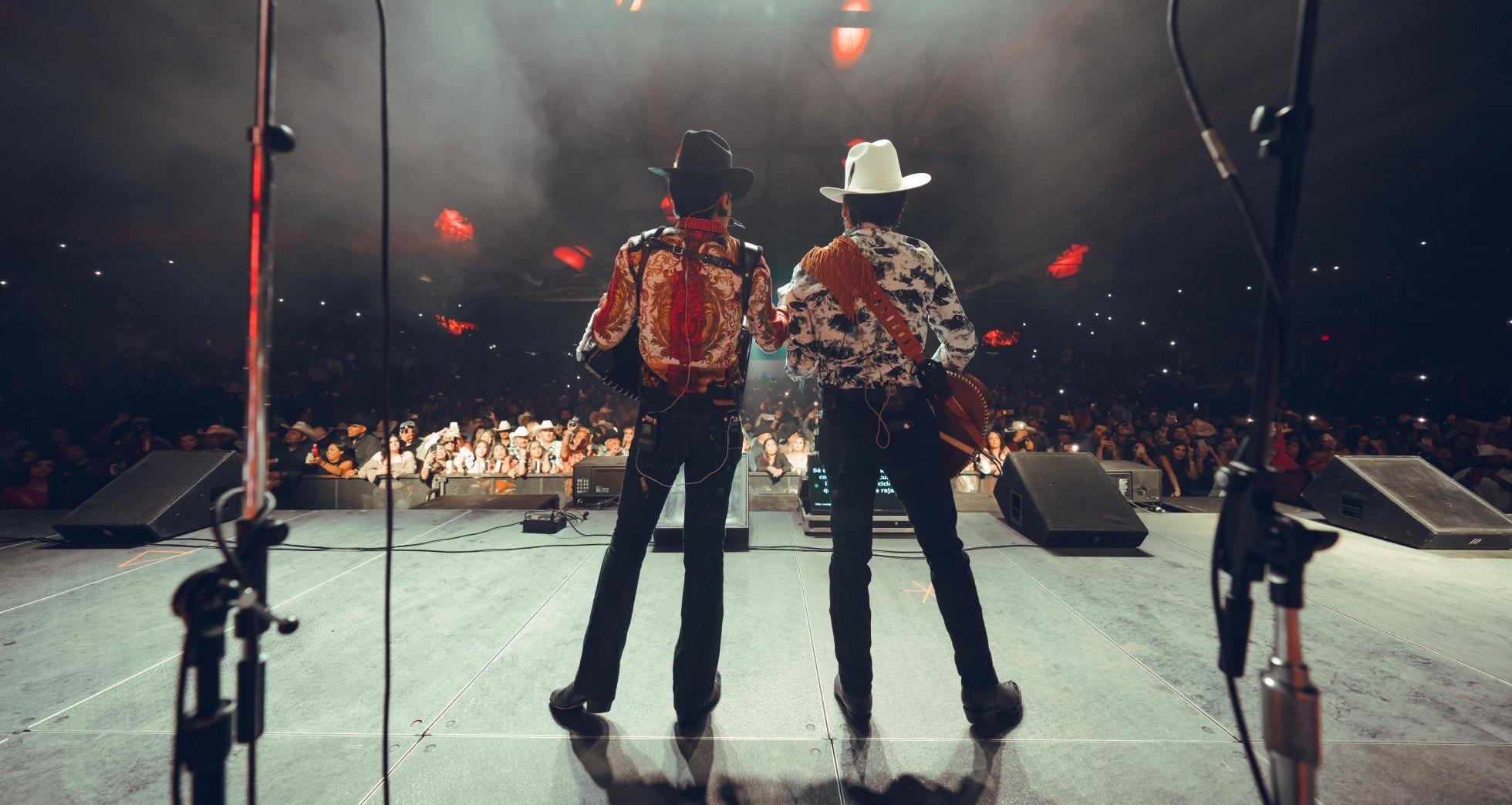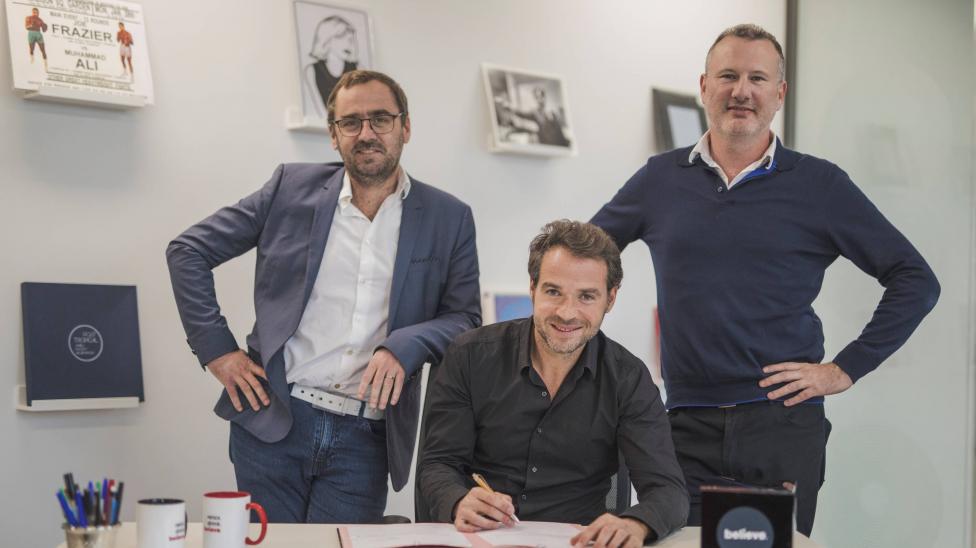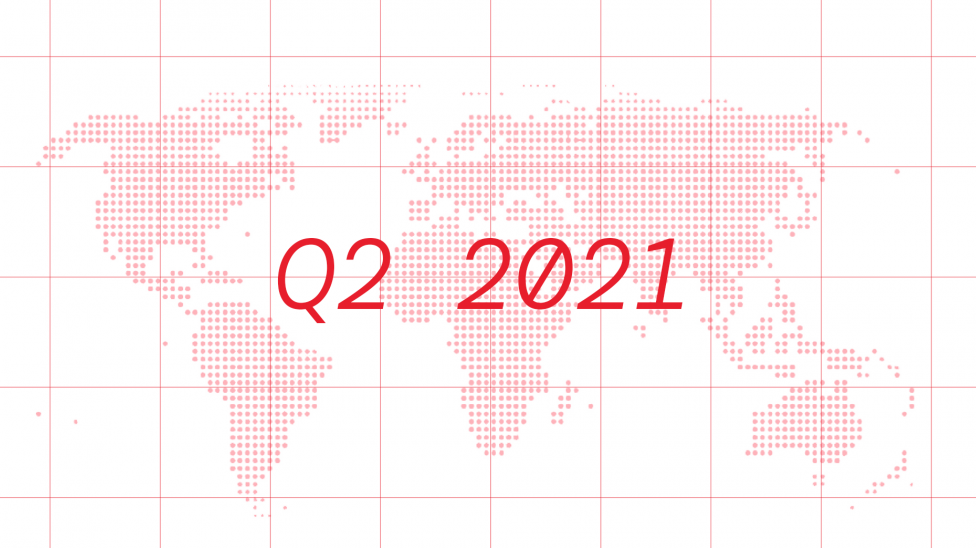
Unleashing the power of local potential: the global rise of Regional Mexican

Here we speak to Marco Cataño, Head of Distribution Mexico, Jose Pablo Molina, Head of Video Americas and Alejandra Olea, Managing Director Americas, about the unstoppable rise of regional Mexican, why the spotlight needs to be put on more female performers in the genre, how streaming is democratizing listening in the country, where regional Mexican’s ascent is helping the independent sector to grow and outgun the majors, why video is the most powerful consumption trend there and where the country’s industry will evolve next.
Understanding regional Mexican: what it is and why it’s growing
Marco: Regional Mexican is a big umbrella term as a music genre because there are many sub-genres. The sub-genres are mostly due to geography and different cultures. Mexico is a big country and so geography plays a big part in that. For example, in the northern part of Mexico, immigration from Germany and other Eastern Europe countries brought polka and polka eventually became banda music because it uses the tuba.
In central Mexico, we have mostly cumbia. It actually comes from Colombia but is also under the umbrella of regional Mexican music.
As for the quintessential Mexican music genre, mariachi, it is mostly from Jalisco in the Bajio region.
What’s been happening for the past 15 or so years is that this type of music is spreading everywhere. It is starting to permeate to the middle classes and the upper classes, becoming bigger and bigger. Most of the pop artists are turning their heads to this music genre; they want to be a part of it and they are collaborating with these artists. Besides urban and reggaeton, which is mostly an import music to Mexico, that is the main music genre in terms of consumption right now.
Alejandra: The rise of regional Mexican reflects the rise at the same time of the local artists and the local perspective. Mexico has historically been overshadowed by its big brother and the imports of North America. Regional Mexican in itself is a genre that is about local folk stories and what’s happening locally in a local conversation. The rise of it is a reflection of how Mexico may be turning for the first time inward and giving more value to its own voices rather than looking outward.
It’s an oral tradition, it’s a story with characters, but it’s not made to honor anybody; rather it is just to reflect what’s going on. It’s a very interesting and complex genre. You can also see its influences in hip-hop and urban. Take reggaeton, for example, where they call out the artist in the lyrics of the song. That comes directly from corrido that calls out the local hero, using music to create ties with the local community.
Marco: With what’s been happening lately, we can call it national pride or see it as young people embracing this type of music that their parents listened to. They are finding new ways to express this type of music, mixed with mainstream pop and other music genres.
There are new genres such as corridos tumbados that are coming from very young artists who are part of regional Mexican. These kids are first- or second-generation Mexican-American, born mostly in California and Texas. They are really pushing the genre forward.
Jose Pablo: We are seeing these artists performing at Coachella and other festivals. Acts like Los Ángeles Azules, Grupo Firme and Banda MS performed there recently. It’s starting to become more mainstream in the US.
Marco: Yahritza y Su Esencia is a 15-year-old girl with her brothers and they play regional Mexican. She started doing songs on TikTok and her first single debuted at number six on YouTube globally. That’s the type of phenomenon that we’re starting to see.
The dynamics of the genre are eventually going to create a superstar from the regional Mexican genre – a superstar like J Balvin, like Shakira, like Maluma.
In a year or two, three at the most, we’re going to have a global superstar coming out of regional Mexican music.
Jose-Pablo: Los Dos Carnales are one of the main breakthrough artists from our label AfinArte Music. They rose to stardom during the pandemic. They did a lot of their work during lock-down, including hosting a few livestream concerts on YouTube that were very successful. They also released four albums in one year.
They play very traditional music, but they have a different look with tattoos and modern clothes. The way they dress and the way they talk really appeals to the younger audience. They have collaborated with a lot of artists already. One of them was Camilo, a huge reggaeton act from Colombia.
Los Dos Carnales earned their first Latin Grammy last November. They won the Best Norteño album category 11 months after they first started releasing music with us.
Marco: Today they're one of the top five regional Mexican artists in the market.
The rise of regional Mexican reflects the rise at the same time of the local artists and the local perspective. Mexico has historically been overshadowed by its big brother and the imports of North America. Regional Mexican in itself is a genre that is about local folk stories and what’s happening locally in a local conversation.
The challenges of breaking female acts in regional Mexican
Alejandra: With regard to women in regional Mexican, I think we still have a long way to go. I really do. I think that Mexico right now is struggling with the way that women are treated and the cultural place of women in Mexico.
In other Latin American countries, the role of women is more central and matriarchal. It’s not the case in Mexico. To me, regional Mexican has been a very close reflection of that culture. Most of the interpreters are men. Most of the composers are men. It is a genre that still has a long way to go.
There’s a lot of opportunity to have women participating in regional Mexican. There’s a growing participation of women executives in the music industry.
Jose Pablo: Adriana Rios is an empowered female performer and there is also Irene Del Rosario. AfinArte is looking to sign more female performers in this genre.
Marco: The genre is actually very male-driven.
Jose Pablo: 80% of the consumers are males and 20% are female. This is why it’s so hard for female artists to break in this genre.
Marco: There are huge female superstars in all music genres, even in regional Mexican, but it is mostly men. I think that’s part of the culture. You can say that the regional Mexican genre is very macho in the topics of the songs.
Other female acts are emerging. Angela Aguilar is the daughter of a huge star of mariachi music, Pepe Aguilar of the Aguilar dynasty. Yahritza y Su Escencia is 15 and has just released one EP. I think she could be a superstar as well. Obviously, historically we had Selena. There are many female acts, but the proportion compared to men is smaller.
Streaming has democratized listening in Mexico
Alejandra: Streaming has, to use a very trite phrase, democratized music. It is more accessible to more people and that has created the need to also reflect the communities it caters to there. The barriers to entry are less, not only on the recording side and the production side, but also on the distribution side.
That has influenced the way that we consume music. Streaming has been instrumental in making local genres more widely known. I can be part of the Mexican diaspora as maybe I had to move because of work and live somewhere else. Now that I have a streaming service, I can look at the music that reminds me of my cultural heritage, my family’s heritage, of my past, of my local town. It makes it more accessible.
Streaming has been instrumental in making local genres more widely known. I can be part of the Mexican diaspora as maybe I had to move because of work and live somewhere else. Now that I have a streaming service, I can look at the music that reminds me of my cultural heritage, my family’s heritage, of my past, of my local town. It makes it more accessible
Mexico is the bridge between the US and South America
Marco: Mexico is an important market. It is the main territory in Latin America for Spanish-speaking countries to develop a music career.
According to AMPROFON, the local branch of IFPI, the major labels have close to 85% of the market. Therefore we get mostly imported music. We have the US right across the border, the world’ s superpower in terms of everything, including pop culture. There is some of our music when you go on Spotify, but it is mostly from import.
The independent sector in Mexico is growing steadily
Marco: The streaming era is helping a lot. Regional Mexican, absolutely, and hip-hop are the trailblazers in terms of new labels that are becoming huge because they have huge artists. Most of them start independently, but eventually they go to a major. Recently our biggest rapper Gera MX signed a contract with Sony Music. There comes a point where they can’t resist.
Hip-hop has helped a lot to develop the local independent industry. There's a lack of structure historically in terms of building labels. Establishing a label is not very easy, but this is where we play a part in that, trying to make business happen. We’re starting to see more and more independent labels and independent artists, but the majors have most of the market share.
Alejandra: Mexico historically has not been able to really create a strong local music industry. One of the opportunities that I see right now is that the major labels have had a big influence in how Mexican music has developed, but at the same time they have been the only filter through which it passes.
We know that the majors have a big focus on international pop artists. This hasn’t allowed for big participation of independent local artists. Because there’s much more access to distribute music, we’re seeing the rise of more independent players that are able to monetize things in different ways; you don’t necessarily have to go through the filter of the majors and big multinational companies.
With streaming and with the proliferation of distribution players, you will see the rise of local music labels that are in a better position to stand independently. That’s from a pure market opportunity perspective. I think there has also been a cultural limitation because the artists have not understood how powerful they can be. The rise of regional Mexican is flipping that and artists who never thought they would have a chance to have international success are now seeing how their music travels and how their genres have really good exposure.
Jose Pablo: If you look at the top artists now, they’re not signed to major labels. Grupo Firme is one of the hottest artists right now in regional Mexican and they're independent, distributing everything with TuStreams (TANGO). Other huge talents are coming from independent labels like AfinArte Music, DEL Records and Rancho Humilde.
In the case of regional Mexican, the major labels are not the top players in the game yet. They’re trying to be, but it’s the independents who are really winning the game right now.
Hip-hop has helped a lot to develop the local independent industry. There's a lack of structure historically in terms of building labels. Establishing a label is not very easy, but this is where we play a part in that, trying to make business happen. We’re starting to see more and more independent labels and independent artists, but the majors have most of the market share.
Mexico is a video-centric market
Jose Pablo: YouTube is the main platform for music consumption in Mexico by far. Some studies show that 45% of music is consumed through YouTube, which is much higher than Spotify or Apple Music. Video is huge here. We just started delivering videos to the new Facebook free music video platform as Facebook is now trying to compete with YouTube.
We’ve seen a lot of success with Facebook because in Mexico the data plans of the phone services include free Facebook access for people. Many people don’t consume YouTube on their phones because it costs them data.
In terms of volume, Spotify is the main player here and Apple Music is really struggling to compete with them. Amazon Music is growing really fast in Mexico.
Marco: TikTok is shifting everything in terms of how we consume music. You can see the echo of TikTok and Spotify in Mexico. YouTube and the video format is extremely popular here. That’s why TikTok is considered one of the main platforms for Mexico.
Mexico City for Spotify is considered the world Mecca of music streaming. This is because of the population density; there’s huge consumption. You can see for many top international artists worldwide that their first territory is often Mexico City.
Jose Pablo: Most people in Mexico still don’t have access to the main audio DSPs so they rely heavily on free services like Facebook or YouTube to consume music.
On YouTube, we are seeing the majority of consumption in a 27-34-year-old age group. It’s 3.5% for 13-17 year olds, 25.8% for 18-24s, 34.1% for 25-34s, 23.1% for 35-44s and only 9% for 45-54s. It is mostly millennial consumers on YouTube.
Catalog is very important for all consumers. We’re rethinking the way we set this up on YouTube, for example, we’re creating compilation videos. Instead of uploading one video from an artist, we’re now doing a one-hour-long video of an act’s greatest hits or the best romantic songs from the 1980s using our catalog.
We are seeing that the algorithm on Facebook has been recommending our music to these kinds of users. We are seeing much more streaming on Facebook for catalog videos than on YouTube because the consumers for this kind of music, who are older, are on this platform.
Radio remains a kingmaker – and that comes with its own challenges
Marco: Radio still plays an important part when you want to break an artist nationwide. If you want to break a superstar, you have to go to radio eventually.
YouTube is the main platform for music consumption in Mexico by far. Some studies show that 45% of music is consumed through YouTube, which is much higher than Spotify or Apple Music. Video is huge here.
The neighboring rights conundrum still has to be solved
Marco: We have neighboring rights in Mexico, and the organization handling it is SOMEXFON but it’s very hard to enforce neighboring rights here in Mexico. It’s baby steps at this point. TV and radio are more manageable for them, but live music and restaurants... I’ve heard stories about their agents going into a bar and trying to have them affiliate so they can pay neighboring rights. The drug cartels just tell them to leave.
Those are the difficulties that they have to deal with in terms of neighboring rights. It is growing, but at this point mostly major labels get the money from neighboring rights because, when it’s paid, it’s divided by market share.
Countries like Argentina are very advanced compared to Mexico in terms of neighboring rights.
The evolution and future of the Mexican music industry
Marco: Artists and labels are beginning to become more educated in terms of the music industry and data. That’s always good news.
At times, it’s very hard for us to have conversations about music distribution. One would assume that it’s common knowledge at this point, but it’s not. Many of the artists who have huge numbers on DSPs and at live shows don’t understand the business at all.
What’s happening with regional Mexican is like a gold rush right now.
We are regionalizing our sales force. We’re going to have someone in the northern Pacific and in Monterrey. We have people now who specialize in those areas in the country.
The genre will keep growing. The diaspora in the US will keep growing as well. The influence of the Latinx in the US is evolving: this is the so-called “brown power”. It’s growing and they are bringing their Mexican roots as well as their music with them.
Alejandra: I see two types of growth. I see sub-genres of the regional Mexican genre growing internationally and I see big opportunities for further audience development in the US and Canada. I’m talking about two things: growth in numbers of listeners; but also growth in revenue.
Marco: In Brazil, which is a world of its own, they have their own regional music, and one genre in particular called Sertanejo It is very similar to regional Mexican.
We’re working with the Brazilian team to maybe one day have a big crossover of the markets because Brazil is the final frontier in the continent. It is huge, but it is mostly local consumption
One of the main messages I want to communicate is that Mexico and Mexican-American culture are the same market. There’s the border, but it doesn’t apply to music consumption, culture and influence.
Want to know more about Believe Americas? Check out our local page for more information
About Marco Cataño, Head of Distribution Mexico:

Marco Cataño is a renowned music industry professional with 25 years of experience. With a degree in Marketing from Tec de Monterrey, he decided to follow his passion for music and began his professional career at BMG Entertainment Mexico as A&R for RCA Records. He later worked at Sony Music Mexico as A&R Manager for Columbia Records and at Warner Music Mexico as A&R Director. Some of the artists he has worked with include iconic Latin superstars such as Alejandro Fernández, Café Tacvba, Jesse & Joy, Pesado, Ana Gabriel, Maldita Vecindad and Alejandra Guzmán, among others. Marco expanded his knowledge to other fields of the music industry as Head of Entertainment Relations for Gibson Brands in Mexico. With the advent of the streaming era, he worked at Altafonte as Country Manager. Since joining Believe as Head of Distribution, Marco’s focal points have been strengthening the Believe brand in the Mexican territory and signing independent superstars such as Remmy Valenzuela, Jesús Adrian Romero and Duelo, for a start.
About Jose Pablo Molina, Head of Video Americas:

Jose Pablo Molina has over 8 years of experience working in the music industry. He first started working in music publishing and royalty administration at Royalty Solutions Corp in New York City and then later worked at Roc Nation’s Digital Marketing Department, where he was involved in the planning and execution of digital marketing strategies for emerging Latin artists such as Victoria La Mala and Mozart La Para and top artists like Shakira and Romeo Santos. Jose later joined OCESA (the third largest promoter in the world) where he was involved in the promotion and production of large-scale events. For the past two years, Jose Pablo has been working at Believe as Head of Video Americas, where he oversees the development of data-driven video and audience growth strategies for hundreds of labels and artists across all video platforms like YouTube, Facebook, TikTok, etc. He is also responsible for managing relationships locally with these platforms to ensure all best practices are applied on each video release.
About Alejandra Olea, Managing Director Americas:

Alejandra Olea is Managing Director of Believe Americas, overseeing all Latin American countries, Spain, Portugal, and US Latin music and Canada. Since joining Believe, Alejandra has achieved 37% growth in LATAM and signed major Latin artists and labels. Previously, Olea was the General Manager for Stingray Music, the largest independent media company in Canada where she oversaw all operations and management of the Latin American region, bringing growth and brand equity for the company. She was also the Vice President of Integrated Sales at BBC Worldwide Latin America & US Hispanic, responsible for channel distribution, program and format sales. Prior to that, Olea held posts at DIRECTV Latin America as a Regional Director, as well as management positions in sales at Sony Pictures Television Latin America and Tepuy/Telemundo International. She has also consulted for Deezer and Naim Media. Olea graduated from the School of Foreign Services at Georgetown University. In 2019, she returned to academia to focus on a specialization on data analytics, graduating from the Harvard Business Analytics Program (HBAP) before joining Believe.


